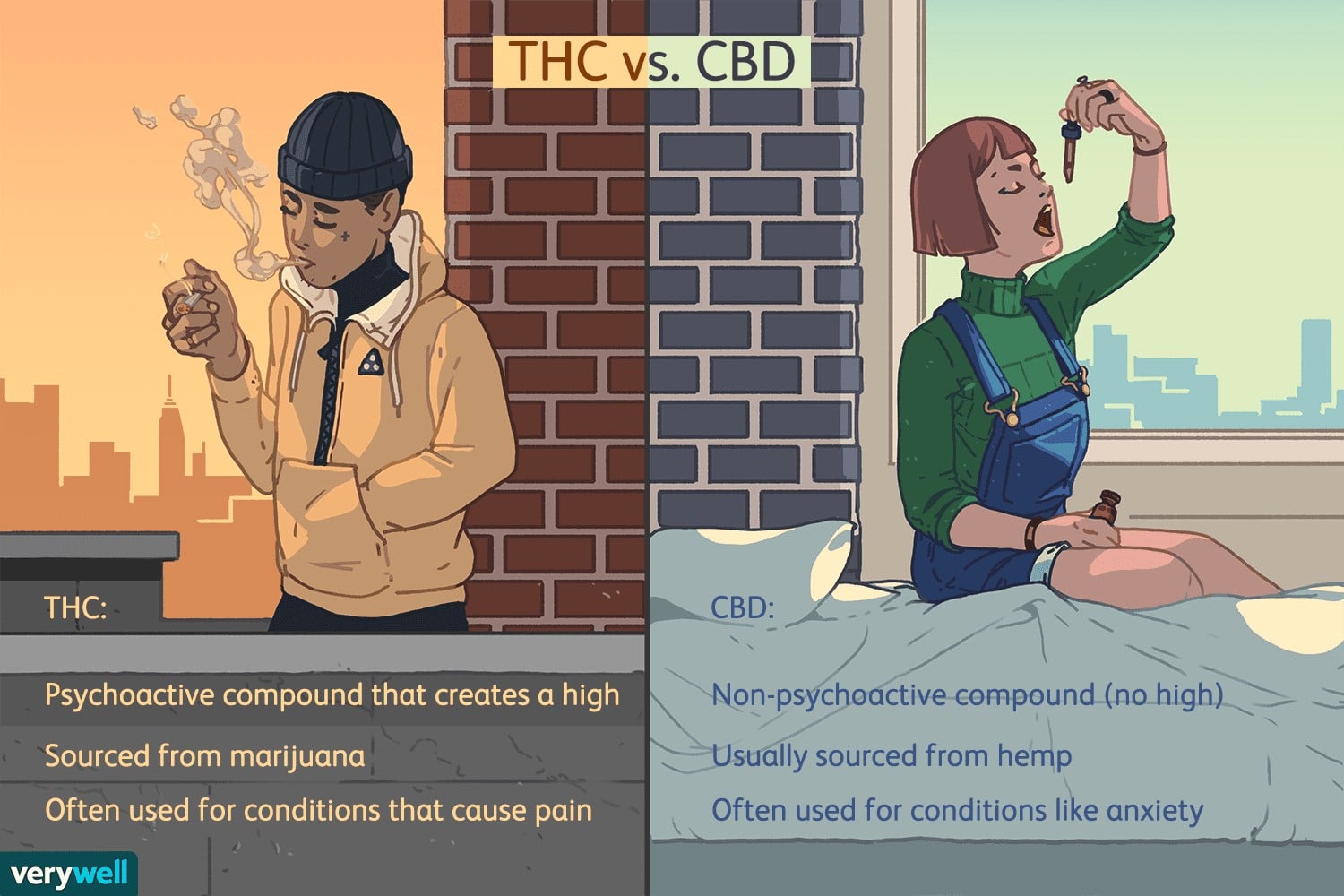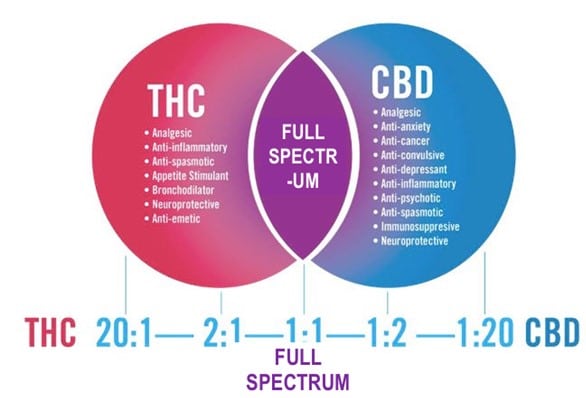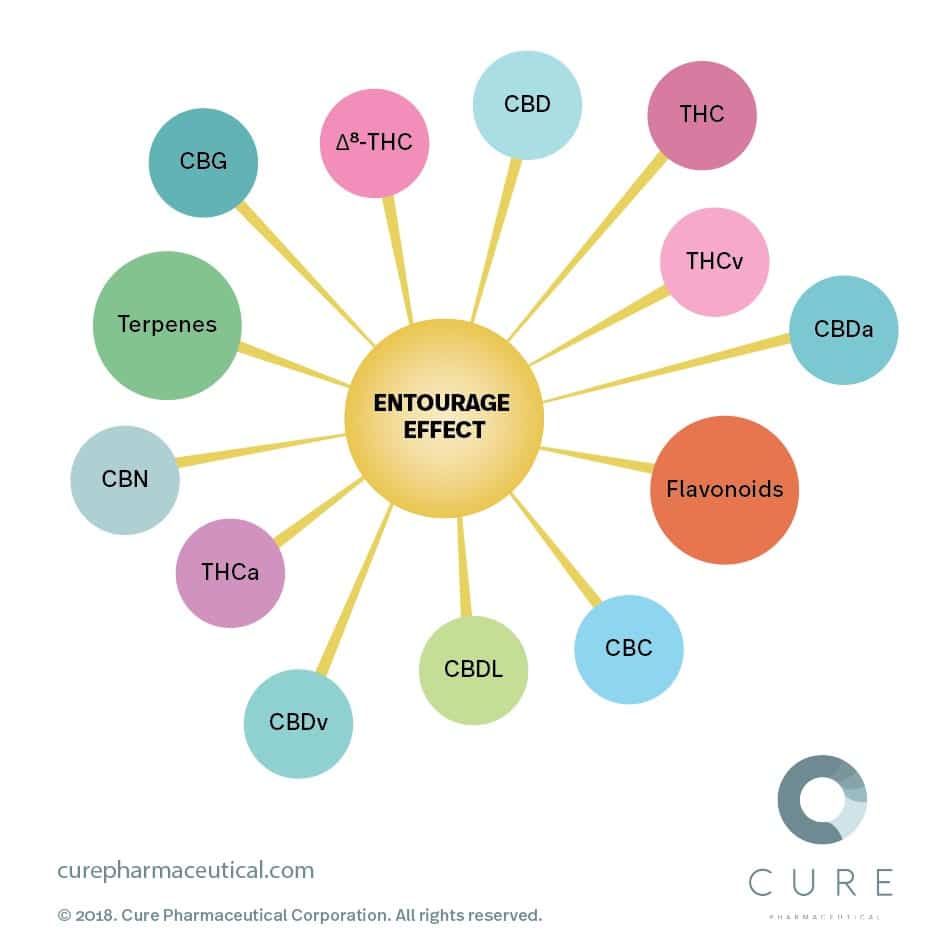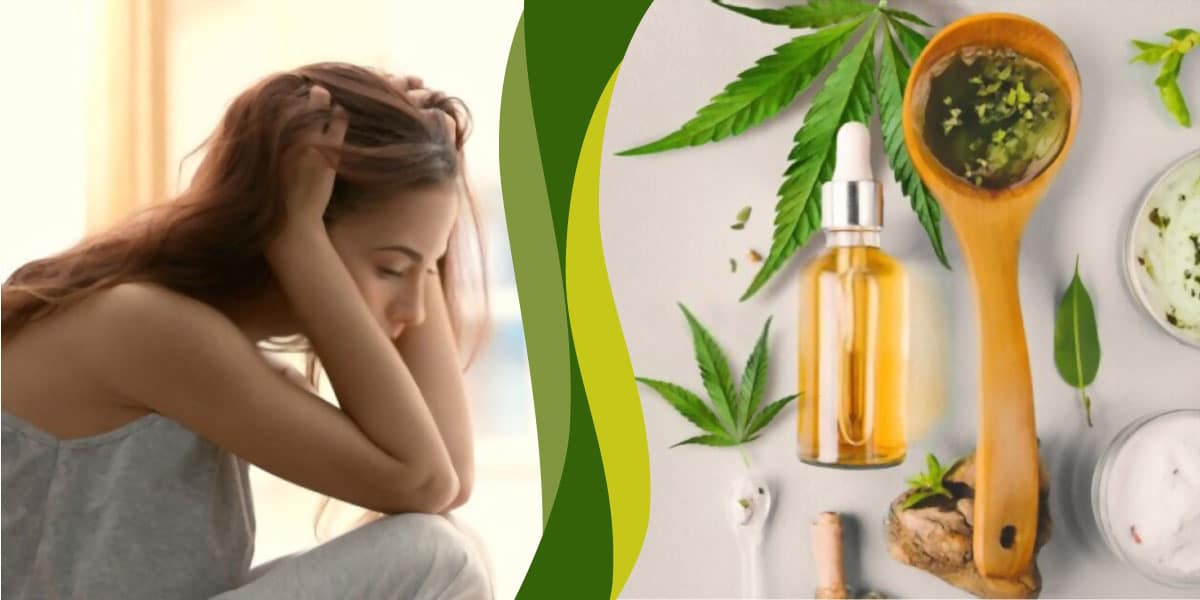The average cannabis plant strain has over 100 cannabinoid chemical compounds in it. Most people are familiar with two particular cannabinoids called CBD and THC. These cannabinoids offer the most benefits to consumers in terms of relaxation, pain relief, and euphoria.

CBD is a safe and legal cannabinoid because it does not cause users to experience psychoactive effects. Users can consume it in the form of a gummy, oil, capsules, or even tinctures. Of all the forms, CBD gummies are particularly effective for a good night’s rest.
THC is the cannabinoid that does cause psychoactive effects, which is why it is illegal in locations where recreational marijuana has not been legalized. Even in locations where it is legal, it’s often kept to a minimal percentage. Take Florida, for example. CBD is legal in Florida, but for THC, the law in the state states that it can’t be more than .3% by weight in CBD oil.
Some people might say that THC is better because it is more potent and offers more euphoric feelings. However, THC has been known to induce some undesirable effects as well. Some of which include panic attacks and paranoia. Novice cannabis users must be aware of these possible unwanted side effects before consuming a high-level THC cannabis product.
There are so many recreational cannabis products available on the market. Some cannabis products have high THC levels and low CBD levels, and others have low THC levels and high CBD levels. The products with high CBD levels do not usually cause users to feel any psychoactive effects. Why is that? Does CBD counteract THC’s psychoactive effects?
To understand the answer to this question, you must understand how each cannabinoid interacts with the body’s endocannabinoid system.
The Endocannabinoid System
We all produce cannabinoid-like molecules to balance the processes of our peripheral nervous system and central nervous system. The endocannabinoid system is responsible for producing these molecules. But when we consume cannabinoids from a cannabis plant, it causes a disturbance to the balance of these natural processes.
THC and CBD both affect the endocannabinoid system to make users feel better. But the way each cannabinoid works with the endocannabinoid system is different. THC cannabinoids attach themselves to the specific receptors of the endocannabinoid system called CB1 receptors.

CB1 receptors are responsible for regulating dopamine production in the central nervous system. For example, if you go for a 30-minute jog outside, you’ll feel a lot more relaxed afterward. Exercise triggers the CB1 receptors to increase the natural dopamine production in the body. That way, your body is less stressed, and your brain can continue to function normally.
When the human body becomes stressed or strained, it produces a neurotransmitter called dopamine to calm it down. We produce this neurotransmitter as we sleep, meditate, listen, exercise, and lie out under the sun. When THC binds to the CB1 receptors, it causes an unnatural boost in the production of dopamine.
For this reason, THC cannabis users can feel so much better without having to exercise, sleep or perform some other action to generate dopamine naturally. Instead, they can unnaturally produce it from THC edibles, vape, and smoke products.
As the dopamine levels rise in this manner, all sorts of unnatural chemical changes occur in the central nervous system. That is how users develop a high and an altered state of consciousness. People don’t usually get high from exercise because the dopamine levels remain regulated. But when THC binds to the CB1 receptors, they can no longer manage the dopamine levels correctly.
CBD remained a mystery to researchers for a long time. They didn’t understand why CBD did not interact with the endocannabinoid system in the same way as THC. It was only recently that they discovered how CBD interacts with it. Basically, the main difference is that CBD does not bind to CB1 receptors. That is why users do not experience psychoactive effects after consuming CBD-based products.
So, what does CBD do in the body? It helps increase the natural production of endocannabinoids, which are the natural molecules that bind to the cannabinoid receptors of the central nervous system. In other words, the CBD causes more natural endocannabinoids to attach themselves to the CP1 receptors rather than binding themselves to them.
Additional research studies show that CBD targets other types of receptors and neurotransmitters of the central nervous system, such as serotonin. That is the neurotransmitter responsible for sustaining cognitive function in the brain and various physiological processes.
A vital thing to note is that CBD does not produce psychoactive effects by interacting with serotonin and those other receptors. The effects that you end up with include stress relief, calmness, tension reduction, and relaxation.
Dual Reactions: CBD and THC
Now you know how each cannabinoid acts in the endocannabinoid system and the effects it has on consumers. But what if you consume CBD and THC at the same time? Will you still experience psychoactive euphoria, or will the CBD counter those effects?
The answer is it depends on the THC and CBD levels found in the cannabis strain you consume. If you were to choose a strain with an equal amount of THC and CBD in it, then you wouldn’t likely experience any psychoactive effects. As the THC binds itself to your CB1 receptors, the CBD will boost your natural endocannabinoid levels simultaneously.
You just learned that CBD has a positive effect on the cognitive function of the brain. Even though the THC will cause a chemical reaction that limits your cognitive function, the CBD’s interactions with other neurotransmitters will be powerful enough to preserve your cognitive function. That means you won’t experience psychoactive effects from consuming an equal amount of THC and CBD together.
1:1 Ratio Strains
A 1:1 ratio for a cannabis strain is when the THC and CBD levels are within a few percentage points of each other. Many people don’t even believe these strains exist. They are only familiar with CBD-based products like CBD moon rocks, which have lower THC levels, and THC-based products with lower CBD levels.
There are at least five cannabis strains with a relatively equal balance of THC and CBD. They are as follows:
- Argyle: It is an Indica strain with a mixture of Afghani and Sensi Star. The cannabinoid levels are 4% to 7% THC and 5% to 8% CBD.
- Dancehall: It is a mixture of Juanita la Lagrimosa and Kalijah. The cannabinoid levels are about 9% THC and 12% CBD.
- Sweet and Sour Widow: It is a CBD-enhanced version of the classic White Widow strain. The cannabinoid levels are 5% to 10% for both THC and CBD.
- Pennywise: It is a strong strain with a mixture of Harlequin and Jack the Ripper. The cannabinoid levels are 12% to 15% for both THC and CBD.
- Cannatonic: It is a powerful medicinal strain with a mixture of MK Ultra and G13 Haze. The cannabinoid levels are 6% and 14% THC and about 12% CBD.
If you consume any one of these cannabis strains, you should feel little to no psychoactive effects. Of course, you might feel some minor psychoactive effects if the THC level percentage is slightly higher than the CBD level percentage of a particular strain. But the difference percentages won’t be more than 6%, so it is not a significant enough difference to produce a strong psychoactive effect.
High-THC, Low-CBD Strains
The complications arise when you start consuming cannabis strains with higher levels of THC than CBD. It is much more difficult for CBD to counteract THC’s psychoactive effects if you have a THC to CBD ratio of more than 8:1.
Here are five cannabis strains with higher levels of THC than CBD.
- Fat Banana: It is a hybrid strain with a mixture of OG Kush and Banana. The cannabinoid levels are around 25% THC and 1% to 5% CBD.
- Chemdawg: It is an Indica-dominant hybrid strain with a mixture of Nepalese Sativa and Thai Sativa. The cannabinoid levels are 26% to 32% THC and 0.01% to 0.10% CBD.
- Godfather OG: It is one of the most potent cannabis strains available. You can expect a combination of GrandaddyPurps, OG Kush, and Cherry Pie. It is an Indica-dominant hybrid strain with about 28% to 34% THC and 0.10% to 0.70% CBD.
- Green Gelato: It is a mildly Indica-dominant hybrid with a combination of Sunset Sherbet and Thin Mini Girl Scout Cookies. This great-tasting strain has about 27% THC and less than 1% CBD.
- Irish Cream: It is a tasty and potent Indica-dominant strain with more than 27% THC and less than 1% CBD. People claim it is like a combination of Cookies & Cream and The Real McCoy.
The vast ratios of these cannabis strains speak for themselves. You cannot expect 1% CBD to counteract the psychoactive effects of 28% THC. It is not going to happen. The THC effects of these strains will dominate your central nervous system.
Low-THC, High-CBD Strains
If you’re new to consuming cannabis, you should start with strains that have low THC and high CBD. You won’t feel any psychoactive effects whatsoever irrespective of the time of the day you consume the High-CBD strain.
Here are five cannabis strains with higher levels of CBD than THC.
- Charlotte’s Web: This strain is named after an American girl named Charlotte Figi who suffered from Dravet syndrome. She consumed cannabidiol oil to stop the seizures that she would get frequently. The cannabis strain she consumed was named after her. It has about 20% CBD and less than 1% THC.
- Harlequin: This strain has a nice blend of Swiss, Thai, Nepali Indica, and Colombian Gold cannabis strains. It only has a CBD-to-THC ratio of approximately 5:2, which is still not enough THC to sedate the consumer. It has 15% CBD and around 6% THC. Most online cannabis merchants have harlequin CBD products available for sale.
- ACDC: People consume this strain because it makes them feel happier and calmer. It comes from Ruderalis and Cannatonic strains, which are known for making users more focused and enthusiastic. It has a 20:1 ratio of CBD-to-THC.
- Harle-Tsu: With a whopping 20:1 ratio of CBD to THC, this strain is an excellent painkiller. It has 22% CBD and less than 1% THC, so you won’t experience any psychoactive effects.
- Ringo’s Gift: This strain is named after a legendary cannabis advocate named Lawrence Ringo. Most people think it was named after the music legend Ringo Starr, but that is not the case. Ringo’s Gift is a combination of Harle-Tsu and ACDC. Your body will experience full relaxation without making your mind wander. This is why it’s one of the most popular strains for people with insomnia. That is thanks to the 24:1 ratio of CBD-to-THC.
If you don’t want to experience any sign of psychoactive behavior, you will be perfectly safe consuming any of these five strains. The best part is that you have more access to high-level CBD strains because they are legal to buy and consume in all 50 states.
The next time you see a high-level CBD strain like the ACDC strain for sale, you should try it out if you’re new to cannabis consumption. If you like what you experience from it, you could upgrade to a 1:1 ratio strain and still experience no psychoactive effects.
Ratio Breakdown of CBD-to-THC Counteractivity
If you’ve made it this far in the article, then you understand that CBD-to-THC ratios are essential for determining the degree of counteractivity between the two cannabinoids. All you need to remember is the most dominant cannabinoid of a strain will be the strongest of the two.
However, you might experience a low level of psychoactive effects in strains with only slightly higher CBD levels. That is why the general law is that you cannot buy or consume any cannabis product with more than 0.3% THC. This only applies to states where recreational marijuana consumption is illegal.
Below is a list of various CBD-to-THC ratios and the level of psychoactive effects they produce for consumers.
1:1 Strain – Consumers might experience psychoactive effects initially, but they will go away quickly as the CBD increases your endocannabinoid levels. That means you shouldn’t experience any paranoia.
2:1 Strain – A 2:1 strain means it has double the CBD compared to THC. You will definitely get a light high from consuming this strain, but it won’t knock you out or intoxicate you. The CBD will do a good enough job of blocking the stronger psychoactive effects. Many consumers feel more creative after using this strain.
8:1 Strain – Even though eight times more CBD exists in this strain, you will still experience a slight high feeling. But the high won’t be significant enough to disturb your daily activities and work productivity. Just don’t take a drug test with this strain in your system.
20:1 Strain – This strain is ideal for novice cannabis consumers. Look for strains with roughly 20% CBD and 1% THC. You won’t experience any psychoactive symptoms, but the small THC level will provide a mild entourage effect.
1:0 Strain – Any strain with less than 0.01% THC will have a 1:0 ratio, signifying that CBD is dominant. Your CB1 receptors will not have any THC cannabinoids binding to them. If you ever get drug tested, you’ll want to consume a 1:0 cannabis strain because no THC will appear in your system.

The takeaway from this ratio list is simple. For most people, the 2:1 strain is the only strain that will cause someone to experience any noticeable psychoactive effects. Everyone has a different tolerance level to THC, depending on how often they’ve consumed it. But you can escape the paranoia side effects with any strain where CBD levels are equal to or greater than THC levels.
The Entourage Effect
Does that make CBD an anti-psychotic? If someone consumes high levels of THC, it is possible to reduce the psychoactive effects if they consume high levels of CBD afterward. Just keep in mind that several other factors can slow down the counteractivity, such as the amount of THC consumed.
When scientists get asked how this is possible, they always refer back to the “entourage effect.” This scientific theory suggests that non-psychoactive cannabis chemical compounds can react synergistically with THC to counteract its psychoactive effects.
In other words, the entourage effect is the notion that all cannabinoids contribute to the effects of a particular cannabis strain.

If someone has very little tolerance to THC, the psychoactive effects can be slowed down if their liver takes a longer time to break down the chemical compounds.
CBD consumption is the best way to hinder the THC breakdown in the liver. It won’t necessarily stop the THC chemical compounds from getting absorbed, but it will make the process extra slow and gradual. That way, the psychoactive effects won’t even be noticeable because the THC cannabinoids will take such a long time to break down completely.
Meanwhile, you will experience the therapeutic benefits of the CBD chemical compounds as they boost the natural endocannabinoids in your body. Scientists continue to study the entourage effect and how it works in the body. They don’t know how CBD interacts with THC because the entourage effect is based on all the cannabinoids reacting together in the endocannabinoid system.
Types of Cannabis and Their Role in Counteractivity
Did you know that the type of cannabis consumed can play a role in how fast you feel its effects? The three main choices are edibles, vapes, and smokables. Which one do you think will interact with your endocannabinoid system the fastest?
When you smoke and vape cannabis strains, you will feel the effects almost immediately. The chemical compounds flow right to your brain and central nervous system. Nothing has to be absorbed or digested like with edibles. That is why so many people choose to vape and smoke versus eating their cannabinoids.
If you’re concerned about counteractivity, you can rest assured that smoking or vaping CBD will allow you to counteract THC’s psychoactive effects much faster. Do not consume CBD edibles to counteract THC because it will take too long for the effects to kick into action.
However, the cannabinoid strength of edibles is far superior to vaping and smoking. The digestive system processes cannabinoids gradually, which means the effects could stay with you for a much longer time. If you consume a cannabis edible that is high in THC and low in CBD, it would be much more difficult for CBD to counteract the psychoactive effects.
For example, let’s say you eat a bunch of gummies from a THC-potent cannabis strain. The THC chemical compounds could spend several hours binding to your CB1 receptors. If you were to smoke or vape a CBD-potent cannabis strain to counteract those effects, you would only experience temporary relief. The CBD effects would hit you quickly and then leave you quickly.
After about two hours, the CBD countereffects start to wear off. As for the THC psychoactive effects, they will continue for another 2 to 3 hours because the edibles are still getting processed in your digestive system. Your only solution would be to consume more CBD vapes and smokables until the THC edibles have been fully digested in your system.
You’re probably wondering whether you could consume CBD edibles to counteract the psychoactive effects of THC edibles. It is an interesting idea that may or may not work. On the one hand, the CBD edibles would get absorbed slowly in your digestive system, causing their counteractive effects to last longer. On the other hand, you’d still have to wait for the CBD’s counteractive effects to begin.
If you consume a THC edible and then wait 2 or 3 hours to consume a CBD edible, it would probably be too late for the psychoactive effects to be counteracted. You’d need to give each edible at least 1 to 2 hours before their effects begin. By the time the CBD counteractive effects start in this scenario, the THC psychoactive effects would have already been there for 2 or 3 hours.
Don’t forget about the peak highs. THC edibles will deliver a peak high about 3 to 4 hours after you eat them. Peak highs are when you experience the highest sensation of paranoia and euphoria. If your CBD edibles are just starting to get absorbed in your digestive system, their effects will be minor compared to the peak high effects. You’ll have to wait for the peak high to go away first.
The Solution
If you want CBD edibles to counteract the psychoactive effects of THC edibles, you must consume both edibles simultaneously. It is the only way to ensure that the CBD compounds will get absorbed at the same time as the THC compounds. Otherwise, the slowness of the digestive system will prevent the CBD from counteracting the THC in time.
The one exception is the ratios. If you consume one edible with 28% THC and another edible with 10% CBD simultaneously, do not expect the CBD to counteract the effects of the THC. As you learn from the ratio section, the CBD levels must be equal to or greater than the THC levels. This applies to all methods of consumption, whether you eat, vape, or smoke cannabis.
Counteractivity is Not a Legal Defense
You must check the laws of your state regarding the consumption of THC. If you don’t live in a state where recreational marijuana is legalized, then you cannot consume any product with more than 0.3% THC under any circumstances. It doesn’t matter if you attempt to counteract the psychoactive effects by consuming CBD. The authorities aren’t going to care about that.
Please note that CBD does not eliminate any traces of THC in your body. Even if you successfully counteract the psychoactive effects, the THC will still be in your system for a while. In fact, THC can be detected in your hair for up to 3 months after you first consume it. You better hope no one does a drug test on your hair, or you might be in trouble.
Fortunately, most drug tests are conducted on urine and blood. The good news is that THC does not stay in urine and blood for longer than three days. And if anyone gives you a saliva test, the THC will only be in your mouth for two days. Just avoid consuming any THC within three days before a scheduled drug test, and you’ll be fine.
Excessive CBD consumption will not change the duration of THC traces in the body. Your reason for counteracting psychoactive effects should be a personal one. If you don’t want to feel paranoid, delusional, or ultra-euphoric, you have a good reason to consume CBD to counteract the effects.
But that begs the question, why would you want to consume vast amounts of THC if you don’t want to get high? Experienced cannabis users understand which strains make them high and how much is too much for their bodies. It is the novice users that usually have bigger problems with psychoactive effects. They don’t understand their limit for cannabis consumption.
As a result, the novices consume too much cannabis and find higher THC amounts than they realized. Since most novices don’t like losing their sense of reality and control, they will want to counteract the psychoactive effects quickly. Only a high-level CBD strain can make this happen.
Conclusion
Does CBD counteract THC’s psychoactive effects? There is no definite answer to this question. Various research studies have shown that CBD will counteract a significant portion of THC’s psychoactive effects, depending on the CBD-to-THC ratio.
Remember that CBD and THC work in harmony with each other. People experience feelings of relaxation and euphoria because of their effects. If you have higher CBD levels than THC in your cannabis strain, you won’t experience severe psychoactive effects quite as much. But you will still experience the entourage effect, which offers a small dose of euphoria without causing paranoia.
Most cannabis users want only some euphoria with no paranoia. They’re not happy consuming a CBD dominant strain with little to no THC because the euphoric sensation is not as significant. Consumers want at least an 8:1 ratio of a cannabis strain because it is the borderline for delivering euphoria without psychoactive effects. A 20:1 ratio is not powerful enough for experienced cannabis users.
Are you an experienced cannabis user or a novice? If you’re the latter, then it is okay to start with a 20:1 ratio strain. It will give your endocannabinoid system the chance to grow accustomed to THC. A newbie will feel the euphoria a lot more quickly than a seasoned consumer. That is why you don’t need much THC at first.
As your endocannabinoid system and CB1 receptors adapt to the THC cannabinoids, it will take higher levels to achieve the same euphoria feeling. That is when you might want to consider switching to a cannabis strain with an 8:1 ratio or 2:1 ratio. You could also consume a 1:1 ratio strain, but it will be less psychoactive than those other two ratios.
Therefore, the safest solution for a novice user would be to choose a cannabis strain with high CBD levels and low THC levels. You’re less likely to experience panic and paranoia if you consume these strains. Once you grow more tolerant of the cannabis effects, you could perhaps explore other strains with higher THC levels at that time.

